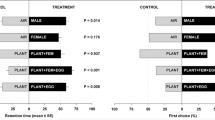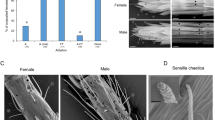Abstract
Egg parasitoids are able to find their hosts by exploiting their chemical footprints as host location cues. In nature, the apolar epicuticular wax layer of plants that consists of several classes of hydrocarbons serves as the substrate that retains these contact kairomones. However, experiments on chemical footprints generally have used filter paper as substrate to study insect behavior. Here, we explored the ability of Trissolcus basalis (Scelionidae) females to discriminate between footprint cues left by male and female Nezara viridula (Pentatomidae) on leaves of their host plant Brassica oleracea (broccoli). Furthermore, we analyzed the chemical composition of the outermost wax layer of broccoli leaves to evaluate the degree of overlap in insect and plant cuticular hydrocarbons that could lead to masking effects in the detection of footprint cues. Our results showed that B. oleracea epicuticular wax retains the chemical footprints of adult bugs and allows T. basalis females to differentiate hosts of different sex. Traces of female bugs elicited more extensive searching behavior in egg parasitoids than traces of males. The application of n-nonadecane, a compound specific to male N. viridula, on the tarsi of female bugs prevented parasitoid females from distinguishing between host male and host female footprints. Analyses of B. oleracea leaves revealed that epicuticular waxes were mainly composed of linear alkanes, ketones, and secondary alcohols. Alkanes were dominated by n-nonacosane (nC29) and n-hentriacontane (nC31), while male-specific n-nonadecane (nC19) was absent. The ecological significance of these results for parasitoid host location behavior is discussed.



Similar content being viewed by others
References
Aldrich, J. R. 1996. Sex pheromones in Homoptera and Heteroptera, pp. 188–233, in C. W. Schafer (ed.) Studies on Hemipteran Phylogeny. Proceedings Thomas Say Publications in Entomology, Entomol. Soc. Am., Lanham, MD.
Aldrich, J. R., Lusby, W. R., Kochansky, J. P., and Lockwood, J. A. 1987. Pheromone strains of the cosmopolitan pest, Nezara viridula (Heteroptera: Pentatomidae). J. Exp. Zool. 244:171–175.
Baker, E. 1974. Influence of environment on leaf wax development in Brassica oleracea var Gemmifera. New Phytol. 73:955–966.
Boo, K. S., and Yang, J. P. 2000. Kairomones used by Trichogramma chilonis to find Helicoverpa assulta eggs. J. Chem. Ecol. 26:359–375.
Bown, A. W., Hall, D. E., and Macgregor, K. B. 2002. Insect footsteps on leaves stimulate the accumulation of 4-aminobutyrate and can be visualized through increased chlorophyll fluorescence and superoxide production. Plant Physiology. 129:1430–1434.
Chabi-olaye, A., Schulthess, F., Poehling, H. M., and Borgemeister, C. 2001. Host location and host dis- crimination behavior of Telenomus isis, an egg parasitoid of the African cereal stem borer Sesamia calamistis. J. Chem. Ecol. 27:663–678.
Colazza, S., Rosi, C. M., and Clemente, A. 1997. Response of egg parasitoid Telenomus busseolae to sex pheromone of Sesamia nonagrioides. J. Chem. Ecol. 23:2437–2444.
Colazza, S., Salerno, G., and Wajnberg, E. 1999. Volatile and contact chemicals released by Nezara viridula (Heteroptera: Pentatomidae) have a kairomonal effect on the egg parasitoid Trissolcus basalis (Hymenoptera: Scelionidae). Biol. Control. 16:310–317.
Colazza, S., Aquila, G., De Pasquale, C., Peri, E., and Millar, J. 2007. The egg parasitoid Trissolcus basalis uses n-nonadecane, a cuticular hydrocarbon from its stink bug host Nezara viridula, to discriminate between female and male hosts. J. Chem. Ecol. 33:1405–1420.
Colazza, S., Lo Bue, M., Lo Giudice, D., and Peri, E. 2009. The response of Trissolcus basalis to footprint contact kairomones from Nezara viridula females is mediated by leaf epicuticular waxes. Naturwissenschaften 96:975–981.
Colazza, S., Peri, E., Salerno, G., and Conti, E. 2010. Host searching by egg parasitoids: exploitation of host chemical cues, pp 97–147, in F. L. Cônsoli, J. R. P. Parra, R. A. Zucchi (eds.). Egg Parasitoids in Agroecosystems with Emphasis on Trichogramma. Springer London New York.
Conti, E., Salerno, G., Leombruni, B., Frati, F., and Bin, F. 2010. Short-range allelochemicals from a plant-herbivore association: a singular case of oviposition-induced synomone for an egg parasitoid. J. Exp. Biol. 213:3911–3919.
Durak, D. 2008. Morphology and chemical composition of metathoracic scent glands in Dolycoris baccarum (Linnaeus, 1758) (Heteroptera: Pentatomidae). Acta Zool. 89:193–199.
Durak, D., and Kalender, Y. 2007. Fine structure and chemical analysis of the metathoracic scent gland of Eurygaster maura (Linnaeus, 1758) (Heteroptera: Scutelleridae). Folia Biol. 55:133–141.
Eigenbrode, S. D., and Espelie K. E. 1995. Effects of plant epicuticular lipids on insect herbivores. Annu. Rev. Entomol. 40:171–194.
Fatouros, N. E., Bukovinszkine’kiss, G., Dicke, M., and Hilker, M. 2007. The response specificity of Trichogramma egg parasitoids towards infochemicals during host location. J. Insect Behav. 20:53–6.
Fatouros, N. E., Dicke, M., Mumm, R., Meiners, T., and Hilker, M. 2008. Foraging behavior of egg parasitoids exploiting chemical information. Behav. Ecol. 19:677–689.
Gniwotta, F., Vogg, G., Gartmann, V., Carver, T. L. W., Riederer, M., and Jetter, R. 2005. What do microbes encounter at the plant surface? Chemical composition of pea leaf cuticular waxes. Plant Physiol. 139:519–530.
Howard, R. W., and Blomquist, G. J. 2005. Ecological, behavioral, and biochemical aspects of insect hydrocarbons Annu. Rev. Entomol. 50:371–393.
Huigens, M. E., Woelke, J. B., Pashalidou, F. G., Bukovinszky, T., Smid, H. M., and Fatouros, N. E. 2010. Chemical espionage on species-specific butterfly anti-aphrodisiacs by hitchhiking Trichogramma wasps. Behav. Ecol. 21:470–478.
Hunsche, M., Bringe, K., Schmitz-eiberger, M., and Noga, G. 2006. Leaf surface characteristics of apple seedlings, bean seedlings and kohlrabi plants and their impact on the retention and rainfastness of mancozeb. Pest Man. Sci. 62:839–847.
Kim, K. S., Park, S. H., Kim, D. K., and Jenks, M. A. 2007. Influence of water deficit on leaf cuticular waxes of soybean (Glycine max [L.] Merr.). Int. J. Plant Sci. 168:307–316.
Klomp, H. 1981. Parasitic wasps as sleuthhounds: Response of an ichneumon wasp to the trail of its host. Neth. J. Zool. 31:762–772.
Lewis, W. J., Nordlund, D. A., Gueldner, R. C., Teal, P. E. A., and Tumlinson, J. H. 1982. Kairomones and their use for management of entomophagous insects. XIII. Kairomonal activity for Trichogramma spp. of abdominal tips, excretion and a synthetic sex pheromone blend of Heliothis zea (Boddie) moths. J. Chem. Ecol. 8:1323–1331.
Lo Giudice, D. 2009. Contact chemo-orientation in insect parasitoids: the case study of mate-finding in Metaphycus luteolus and host-finding in Trissolcus basalis. PhD dissertation. University of Palermo, Palermo, Italy.
Müller, C., and Riederer, M. 2005. Plant surface properties in chemical ecology. J. Chem. Ecol. 31:2621–2651.
Peri, E., Sole, M. A., Wajnberg, E., and Colazza, S. 2006. Effect of host kairomones and oviposition experience on the arrestment behavior of an egg parasitoid. J. Exp. Biol. 209:3629–3635.
Powell, G., Maniar, S. P., Pickett, J. A., and Hardie, J. 1999. Aphid responses to non-host epicuticular lipids. Entom. Exp. App. 91:115–123.
Purdy, S. J. and Truter E. V. 2010. Constitution of the surface lipid from the leaves of Brassica oleracea (var. capitata (winnigstadt)). iii. nonacosane and its derivatives. Proc. R. Soc. Lond. B 1963 158:553–565.
Riedel, M., Eichner, A., and Jetter, R. 2003. Slippery surfaces of carnivorous plants: composition of epicuticular wax crystals in Nepenthes alata Blanco pitchers. Planta 218:87–97.
Rostás, M., and Wölfling, M. 2009. Caterpillar footprints as host location kairomones for Cotesia marginiventris: persistence and chemical nature. J. Chem Ecol. 35: 20–27.
Rostás, M., Ruf, D., Zabka, V., and Hildebrandt, U. 2008. Plant surface wax affects parasitoid’s response to host footprints. Naturwissenschaften 95:997–1002.
Salerno, G., Conti, E., Peri, E., Colazza, S., and Bin, F. 2006. Kairomone involvement in the host speci- ficity of the egg parasitoid Trissolcus basalis (Hymenoptera: Scelionidae). Eur. J. Entomol. 103:311–318.
Salerno, G., Frati, F., Conti, E., De Pasquale, C., Peri, E., and Colazza, S. 2009. A finely tuned strategy adopted by an egg parasitoid to exploit chemical traces from host adults. J. Exp. Biol. 212:1825–1831.
Szafranek, B. M., and Synak, E. E. 2006. Cuticular waxes from potato (Solanum tuberosum) leaves. Phytochemistry 67:80–90.
Vet, L. E. M., and Dicke, M. 1992. Ecology of infochemical use by natural enemies in a tritrophic context. Annu. Rev. Entomol. 37:141–172.
Witjes, S., and Eltz, T. 2009. Hydrocarbon footprints as a record of bumblebee flower visitation. J. Chem. Ecol. 35:1320–1325.
Zygadlo, J., Maestri, D., and Grosso, N. 1994. Alkane distribution in epicuticular wax of some Solanaceae species. Biochem. System. Ecol. 22:203–209.
Acknowledgements
We thank Mauro Lo Bue for assistance in the behavioral bioassays run at University of Palermo, Paolo Lucido for help in the collections of N. viridula from fields, Olga Frank for technical assistance with the GC analysis, and John Marris for constructive comments on the manuscript. The work was partially supported by the German DAAD and the Italian CRUI within the German-Italian bilateral program “VIGONI 2009”.
Author information
Authors and Affiliations
Corresponding author
Rights and permissions
About this article
Cite this article
Lo Giudice, D., Riedel, M., Rostás, M. et al. Host Sex Discrimination by an Egg Parasitoid on Brassica Leaves. J Chem Ecol 37, 622–628 (2011). https://doi.org/10.1007/s10886-011-9957-9
Received:
Revised:
Accepted:
Published:
Issue Date:
DOI: https://doi.org/10.1007/s10886-011-9957-9




